A Landscape Connectivity Approach for Determining Minimum Ecological Lake Level: Implications for Lake Restoration
Abstract
:1. Introduction
2. Study Area
3. Methods
3.1. Framework for Developing a Landscape Connectivity Approach to Determine the Minimum Ecological Lake Level
- (1)
- Simulating landscape patterns of water at different lake levels. In this study, the hydrodynamic module (HD) of MIKE21 software was used to calculate the water depth at different lake levels based on measured topographic and bathymetric data of Baiyangdian Lake. Those grids with water depth greater than 0 m were then identified using ArcGIS and the distribution of water patches was mapped. It is also feasible to obtain the landscape patterns by interpreting Landsat images corresponding to known historical lake levels. However, Landsat images corresponding to different lake levels are not always available.
- (2)
- Calculating the connectivity of water patches. With ArcGIS, water patch areas and edge-to-edge Euclidean distances between patches were calculated. Connectivity was then calculated using CONEFOR software. Commonly used connectivity indexes include the integral index of connectivity (IIC) and the probability index of connectivity (PC).
- (3)
- Determining the minimum ecological lake level. Based on the relationship between connectivity and lake level, the lake level-connectivity (H-C) curve can be obtained. The breakpoint corresponding to the maximum dC/dH can then be determined and identified as the minimum ecological lake level of Baiyangdian Lake.
3.2. Water Landscape Simulation
3.3. Landscape Connectivity
- (1)
- Integral index of connectivity (IIC)where n represents the total number of water patches in the lake landscape, ai(or aj) is the area of an individual patch i (or j), nlij is the number of links in the shortest path between patch i and j, AL is the total area of the lake including water patches and non-water patches. In this approach, there are only two cases of connection and non-connection between two patches. Patches are judged to be connected or not based on the preset distance threshold value. If the distance between two patches is less than the threshold distance, the patches are connected; otherwise, patches are non-connected. The range of IIC is from zero to one, where zero indicates complete isolation between patches and one indicates that the whole lake is completely connected.
- (2)
- Probability index of connectivity (PC)where n, ai, aj and AL have the same meaning as that in Equation (3); is the maximum product probability of dispersal between patches i and j; dij is Euclidean edge to edge distance; k is a constant used to fit the function to user specified relationship between distance and dispersal probability. As with the IIC, the higher the PC value, the better the connectivity of the lake.
4. Results
4.1. Verification of Water Landscape Simulation
4.2. Water Landscape Patterns under Different Lake Levels
4.3. Response of Landscape Connectivity to Lake Level Variations
5. Discussion
5.1. Comparison of the Landscape Connectivity Approach with the Lake Morphology Approach
5.2. Lake Restoration Recommendations Based on the Landscape Connectivity Approach
6. Conclusions
Author Contributions
Funding
Acknowledgments
Conflicts of Interest
References
- Yang, W.; Yang, Z.F.; Zheng, C. Sustainable environmental flow management based on lake quality protection: The case of Baiyangdian Lake, China. Procedia Environ. Sci. 2012, 13, 730–741. (In Chinese) [Google Scholar] [CrossRef] [Green Version]
- Philip, M.; Aladin, N.V. Reclaiming the Aral Sea. Sci. Am. 2008, 298, 64–71. [Google Scholar]
- Ma, R.; Yang, G.; Duan, H.; Jiang, J.; Wang, S.; Feng, X.; Li, A.; Kong, F.; Xue, B.; Amp, J.L. China’s lakes at present: Number, area and spatial distribution. Sci. China Earth Sci. 2011, 54, 283–289. [Google Scholar] [CrossRef]
- Ye, Z.; Li, W.; Chen, Y.; Qiu, J.; Aji, D. Investigation of the safety threshold of eco-environmental water demands for the Bosten Lake wetlands, western China. Quat. Int. 2017, 440, 130–136. [Google Scholar] [CrossRef]
- Gownaris, N.J.; Rountos, K.J.; Kaufman, L.; Kolding, J.; Lwiza, K.M.M.; Pikitch, E.K. Water level fluctuations and the ecosystem functioning of lakes. J. Great Lakes Res. 2018, 44, 1154–1163. [Google Scholar] [CrossRef]
- Shang, S.; Shang, S. Simplified lake surface area method for the minimum ecological water level of lakes and wetlands. Water 2018, 10, 1056. [Google Scholar] [CrossRef]
- Yang, W.; Yang, Z.; Qin, Y. An optimization approach for sustainable release of e-flows for lake restoration and preservation: Model development and a case study of Baiyangdian Lake, China. Ecol. Model. 2011, 222, 2448–2455. [Google Scholar] [CrossRef]
- Shang, S.H. Lake surface area method to define minimum ecological lake level from level-area-storage curves. J. Arid Land 2013, 5, 133–142. [Google Scholar] [CrossRef] [Green Version]
- Yang, W. Variations in ecosystem service values in response to changes in environmental flows: A case study of Baiyangdian Lake, China. Lake Reserv. Manag. 2011, 27, 95–104. (In Chinese) [Google Scholar] [CrossRef]
- Sajedipour, S.; Zarei, H.; Oryan, S. Estimation of environmental water requirements via an ecological approach: A case study of Bakhtegan Lake, Iran. Ecol. Eng. 2017, 100, 246–255. [Google Scholar] [CrossRef]
- Mao, X.; Yang, Z. Functional assessment of interconnected aquatic ecosystems in the Baiyangdian Basin-An ecological-network-analysis based approach. Ecol. Mod. 2011, 222, 3811–3820. [Google Scholar] [CrossRef]
- Wang, Y.Z.; Hong, W.; Wu, C.Z.; He, D.J.; Lin, S.W.; Fan, H.L. Application of landscape ecology to the research on wetlands. J. For. Res. 2008, 19, 164–170. [Google Scholar] [CrossRef]
- Hu, W.; Wang, G. Advances in research of landscape patterns and ecological processes of wetland. Adv. Earth Sci. 2007, 22, 969–975. (In Chinese) [Google Scholar]
- Lindenmayer, D.; Hobbs, R.J.; Montague, D.R.; Alexandra, J.; Bennett, A.; Burgman, M.; Cale, P.; Calhoun, A.; Cramer, V.; Cullen, P.; et al. A checklist for ecological management of landscapes for conservation. Ecol. Lett. 2010, 11, 78–91. [Google Scholar] [CrossRef] [PubMed]
- Ernst, B.W. Quantifying landscape connectivity through the use of connectivity response curves. Landsc. Ecol. 2014, 29, 963–978. [Google Scholar] [CrossRef]
- Taylor, P.D.; Fahrig, L.; Merriam, K.H.G. Connectivity is a vital element of landscape structure. Oikos 1993, 68, 571–573. [Google Scholar] [CrossRef]
- Dembkowski, D.J.; Miranda, L.E. Comparison of fish assemblages in two disjoined segments of an Oxbow Lake in relation to connectivity. Trans. Am. Fish. Soc. 2011, 140, 1060–1069. [Google Scholar] [CrossRef]
- Liu, D.; Wang, X.; Li, C.; Cai, Y.; Liu, Q. Eco-environmental effects of hydrological connectivity on lakes: A review. Resour. Environ. Yangtze Basin 2019, 27, 1702–1715. (In Chinese) [Google Scholar]
- Li, Y.; Zhang, Q.; Cai, Y.; Tan, Z.; Wu, H.; Liu, X.; Yao, J. Hydrodynamic investigation of surface hydrological connectivity and its effects on the water quality of seasonal lakes: Insights from a complex floodplain setting (Poyang Lake, China). Sci. Total Environ. 2019, 660, 245–259. [Google Scholar] [CrossRef]
- Zhang, M.; Wu, X. Changes in hydrological connectivity and spatial morphology of Baiyangdian wetland over the last 20 years. Acta Ecol. Sin. 2018, 38, 4205–4213. [Google Scholar]
- Gao, N.; Li, X.; Zhuge, H. Relationship between raised field structure and europhication extent change of water in Baiyangdian Lake. Wetl. Sci. 2013, 11, 259–265. (In Chinese) [Google Scholar]
- Zhuang, C.; Ouyang, Z.; Xu, W.; Bai, Y. Landscape dynamics of Baiyangdian Lake from 1974 to 2007. Acta Ecol. Sin. 2011, 31, 839–848. (In Chinese) [Google Scholar]
- Wang, W.; Shao, Q.; Yang, T.; Peng, S.; Xing, W.; Sun, F.; Luo, Y. Quantitative assessment of the impact of climate variability and human activities on runoff changes: A case study in four catchments of the Haihe River basin, China. Hydrol. Process. 2013, 27, 1158–1174. [Google Scholar] [CrossRef]
- Lin, W.K.; Tao, L.H.; Min, W.A.; Zi, L.M.; Yi, Z.; Peng, L.W. An analysis of the evolution of Baiyangdian Wetlands in Hebei Province with artificial recharge. Acta Geosci. Sin. 2018, 39, 549–558. (In Chinese) [Google Scholar]
- Hu, S.; Liu, C.; Zheng, H.; Wang, Z. Assessing the impacts of climate variability and human activities on streamflow in the water’ source area of Baiyangdian Lake. J. Geogr. Sci. 2012, 22, 895–905. [Google Scholar] [CrossRef]
- Xu, Z.; Chen, M.; Dong, Z. Researches on the calculation methods of the lowest ecological water level of lake. Acta Ecol. Sin. 2004, 24, 2324–2328. (In Chinese) [Google Scholar]
- Zhang, W.; Jia, Y.; Cui, C.; Yue, C.; Meng, L. Study on change analysis of Baiyangdian based on multi-source data. Water Resour. Inform. 2017, 5, 9. [Google Scholar]
- Zhao, X.; Cui, B.S.; Yang, Z.F. A study of the lowest ecological water level of Baiyangdian Lake. Acta Ecol. Sin. 2005, 25, 1033–1040. (In Chinese) [Google Scholar]
- Yang, Z.F.; Hu, P.; Zhao, Y.; Zeng, Q.H. Study on ecological water demand and safeguard measures of Baiyangdian Lake and the upstream rivers under the background of Xiong’an New Area. J. China Inst. Water Resour. Hydropower Res. 2018, 16, 563–570. (In Chinese) [Google Scholar]
- Cui, B.; Li, X.; Zhang, K. Classification of hydrological conditions to assess water allocation schemes for Lake Baiyangdian in North China. J. Hydrol. 2010, 385, 247–256. [Google Scholar] [CrossRef]
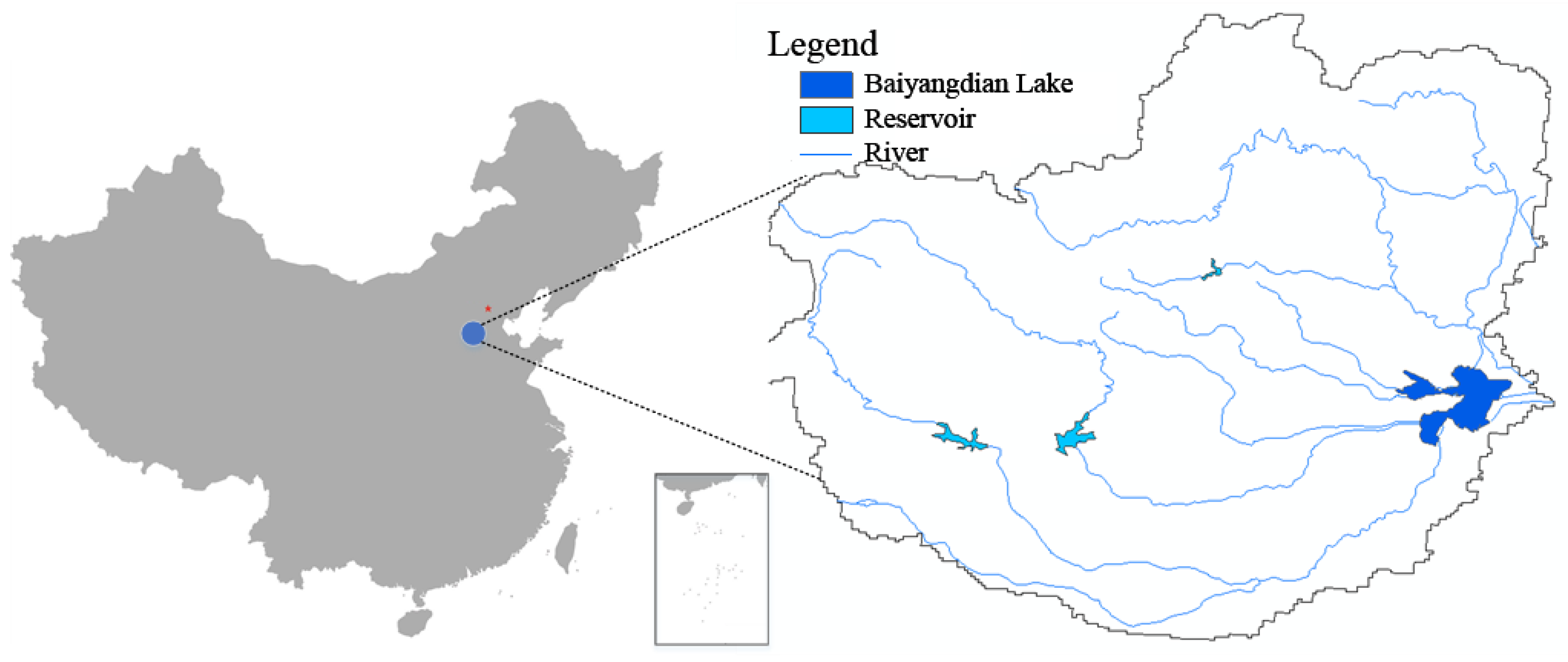


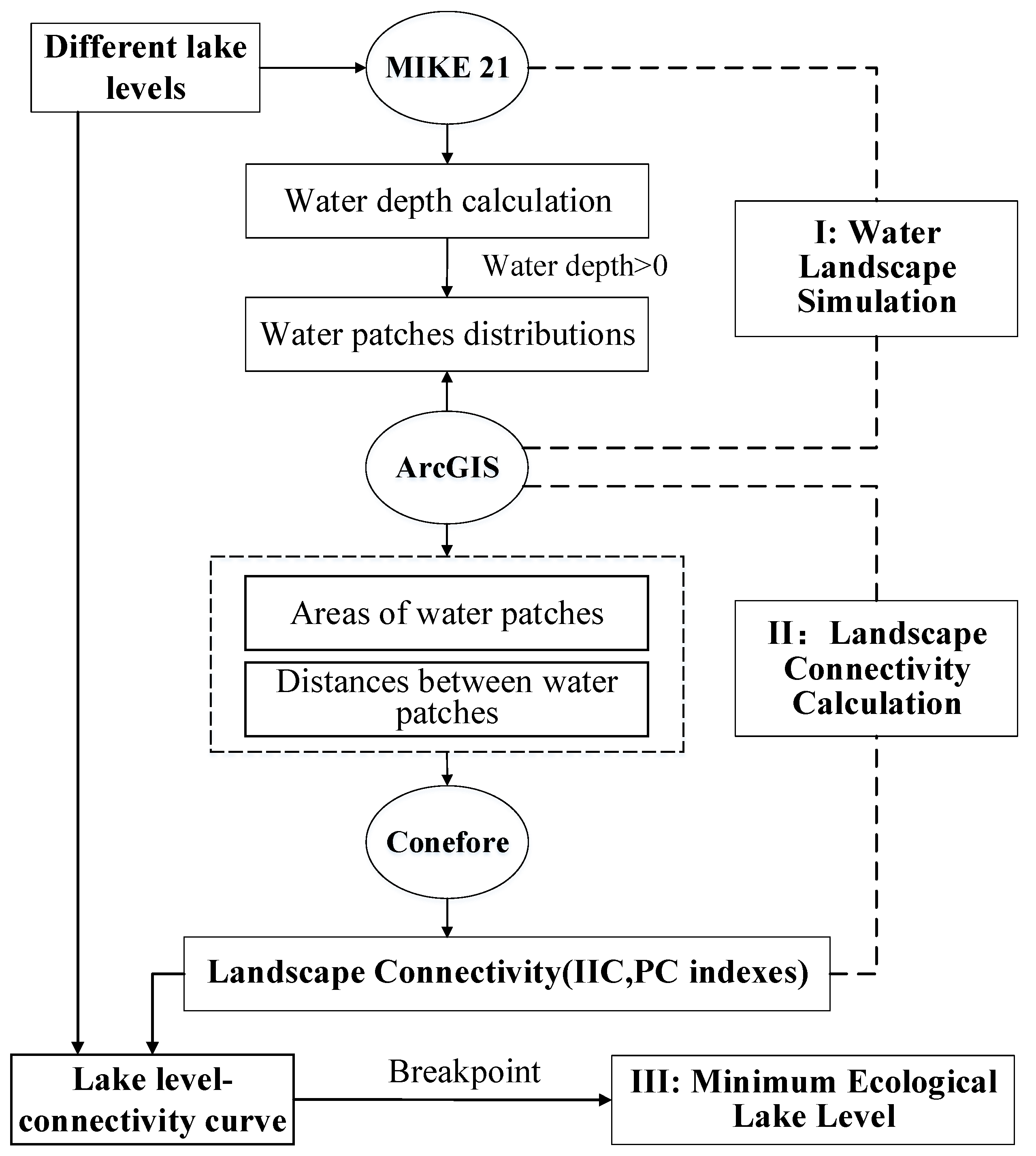

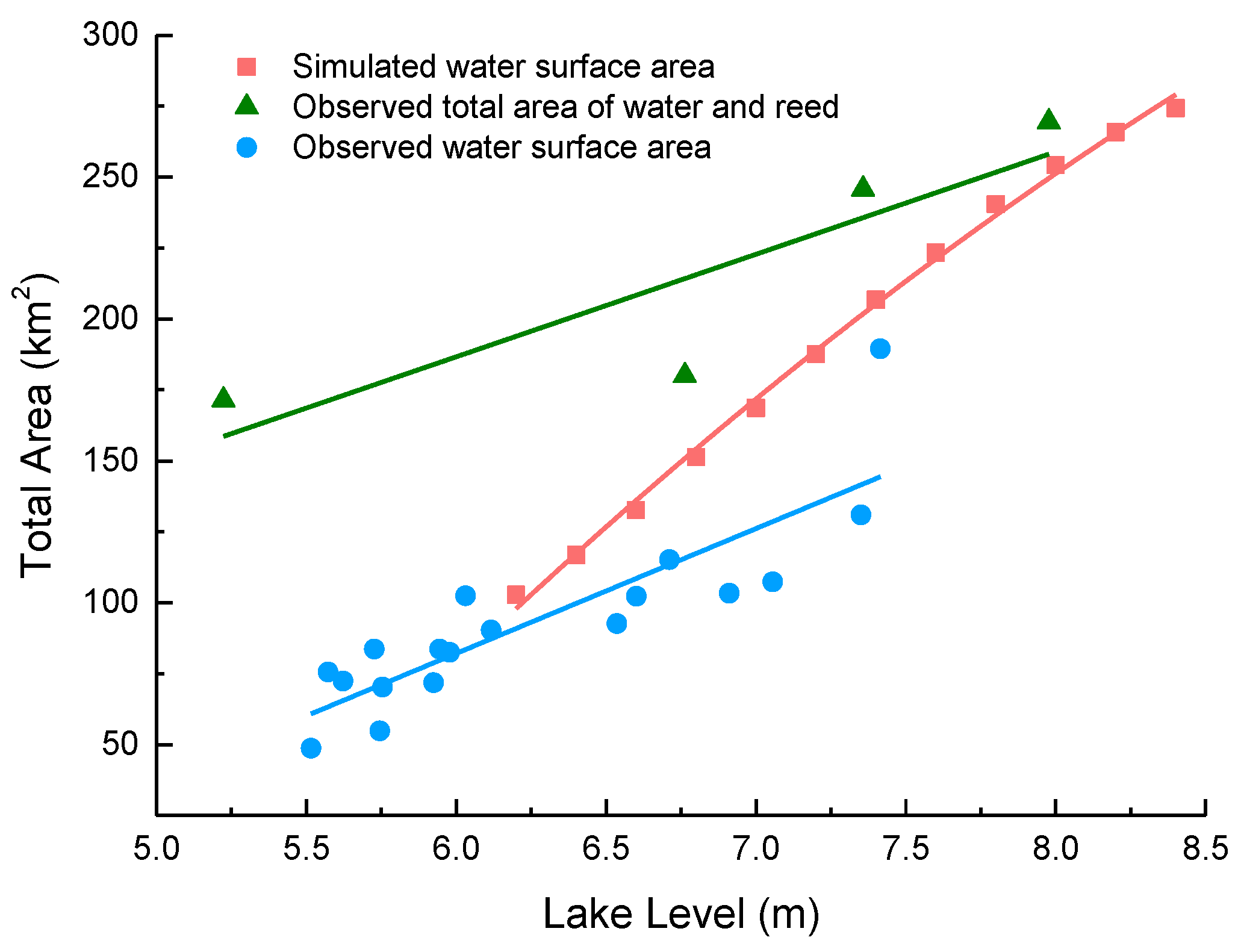
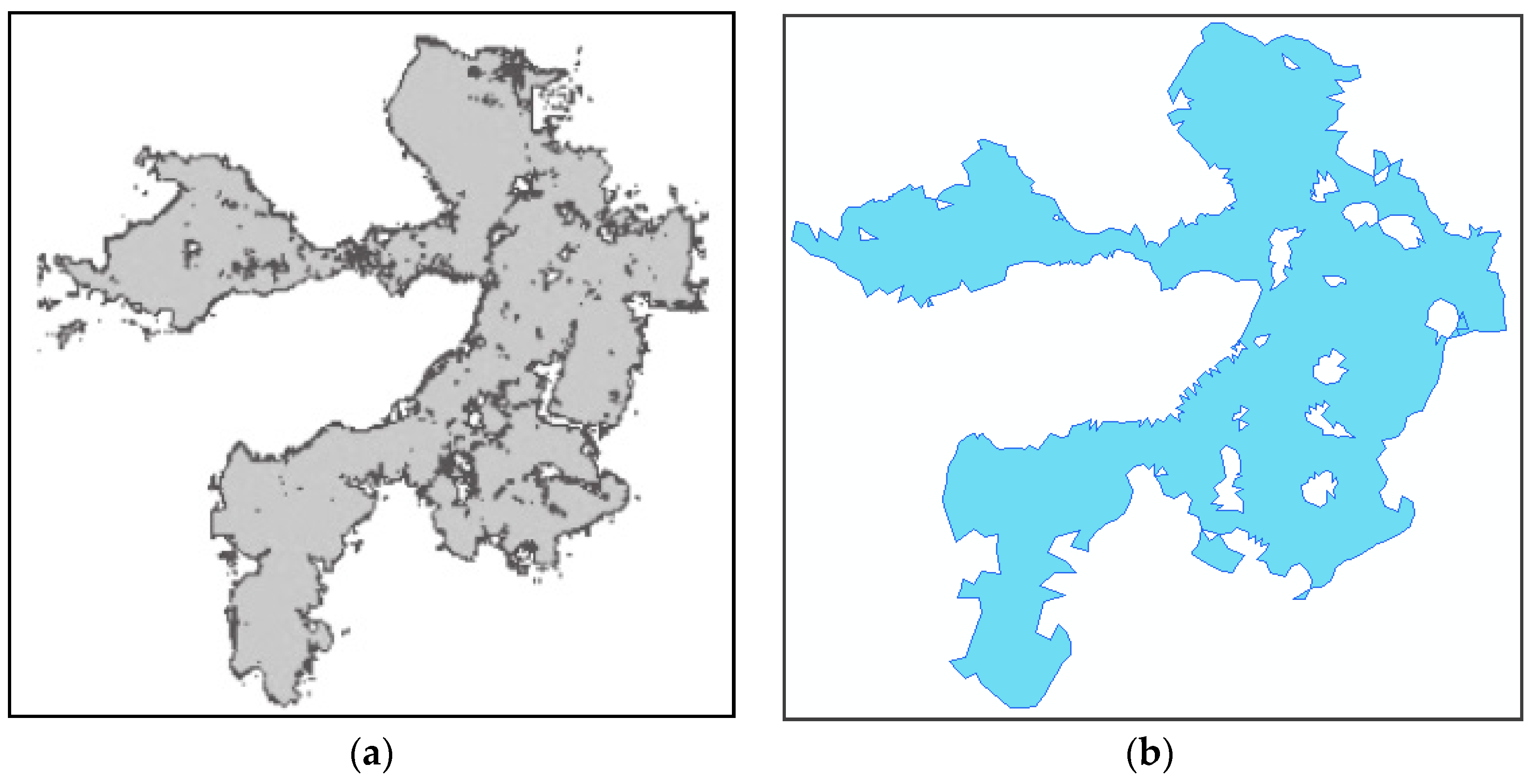
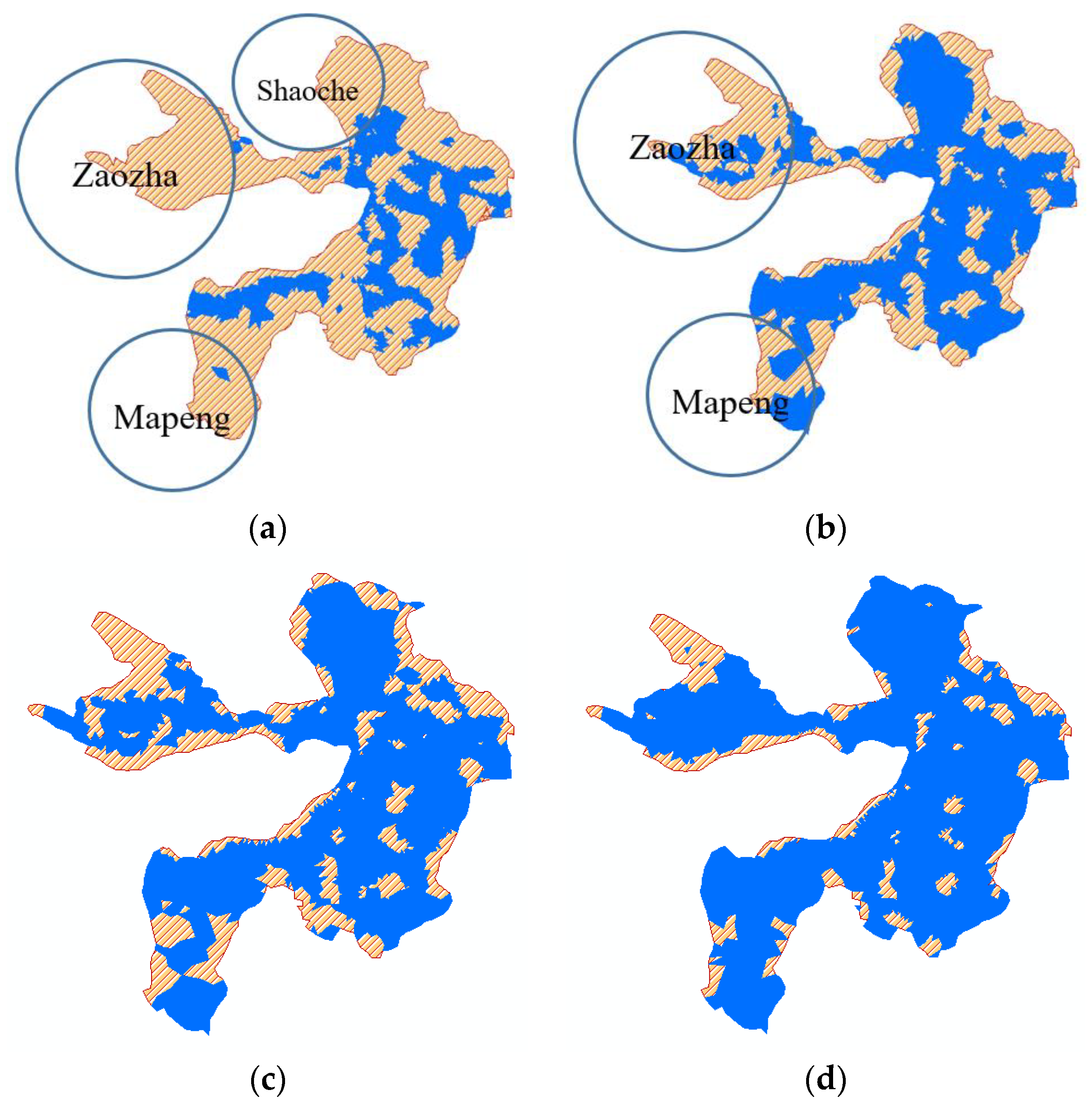
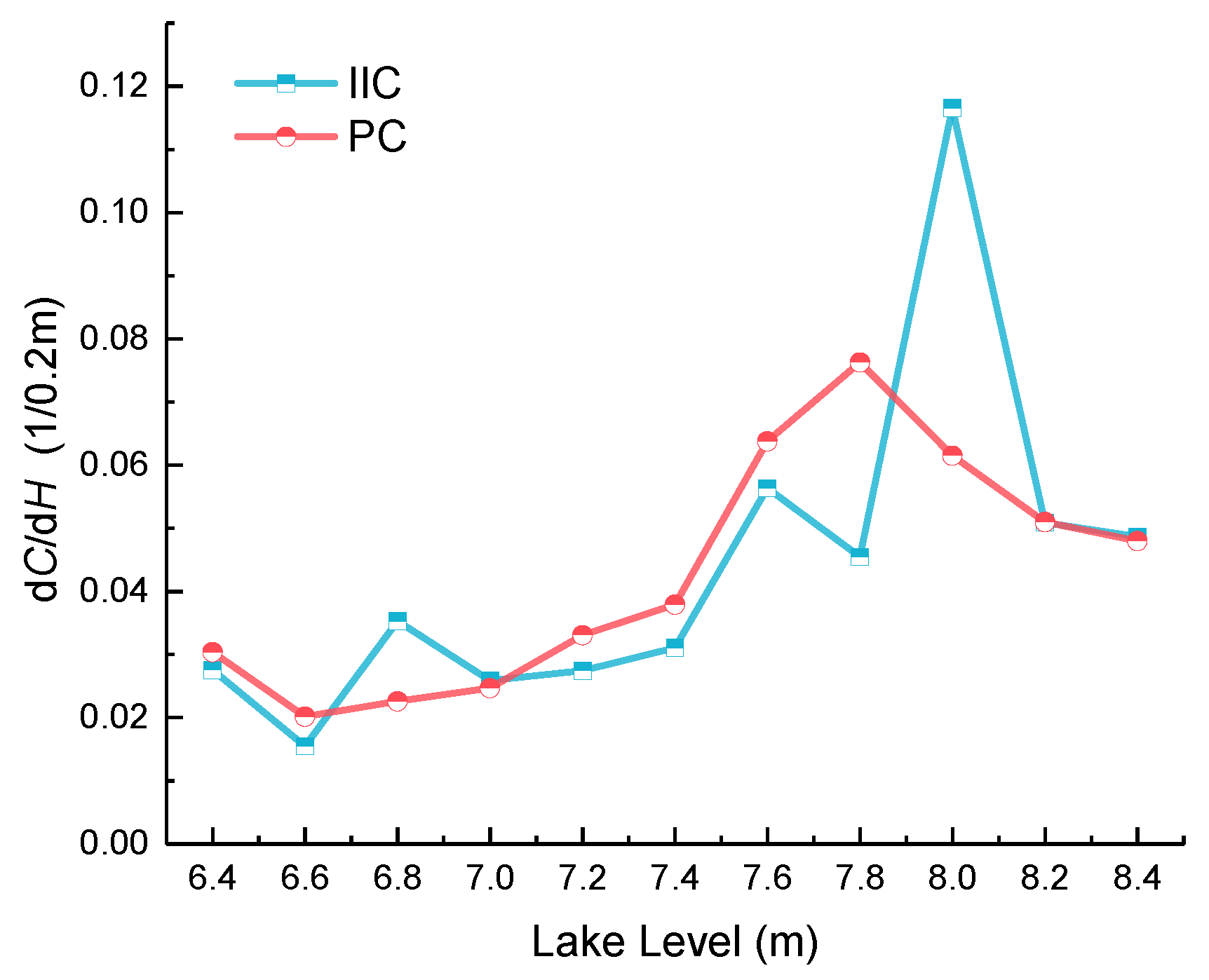
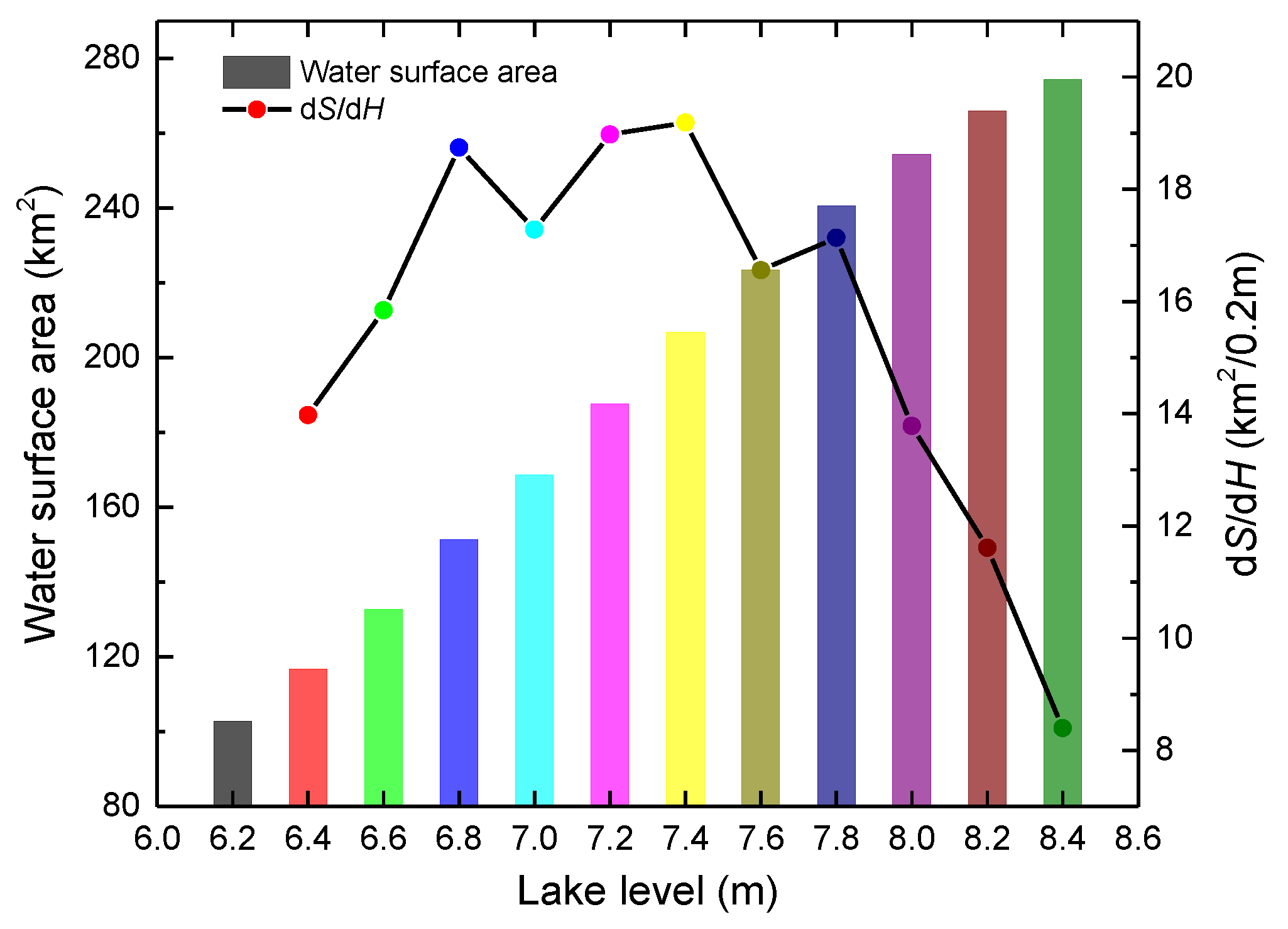

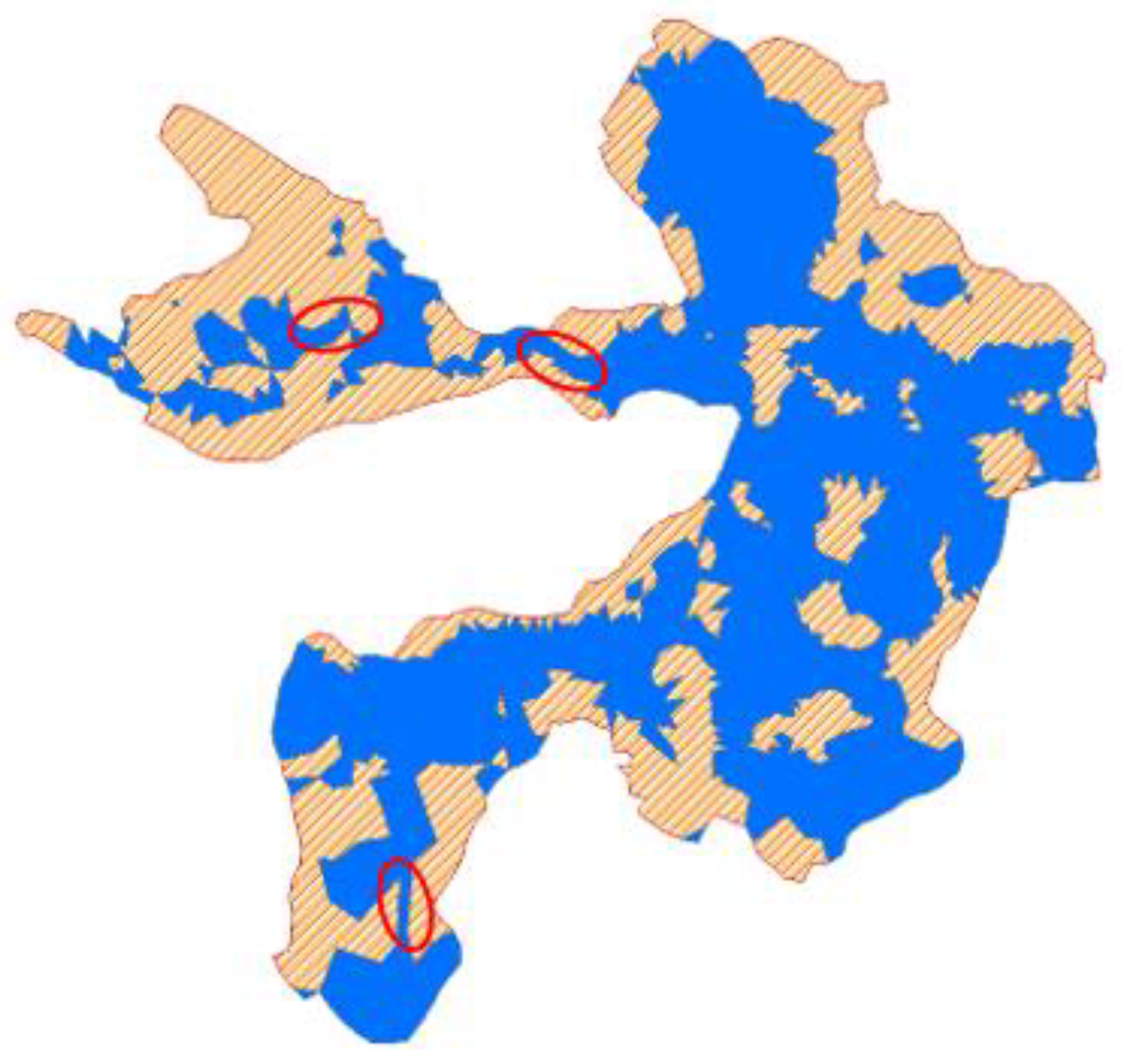
| Parameter | Value |
|---|---|
| CFL | 0.8 |
| Drying depth | 0.005 m |
| Flooding depth | 0.05 m |
| Wetting depth | 0.1 m |
| Coriolis force | 1.4 × 10−4/s |
| Density type | Barotropic |
| Eddy viscosity | 0.3 |
| Manning number | 32 (m1/3/s) |
© 2019 by the authors. Licensee MDPI, Basel, Switzerland. This article is an open access article distributed under the terms and conditions of the Creative Commons Attribution (CC BY) license (http://creativecommons.org/licenses/by/4.0/).
Share and Cite
Liu, D.; Wang, X.; Zhang, Y.-l.; Yan, S.-j.; Cui, B.-s.; Yang, Z.-f. A Landscape Connectivity Approach for Determining Minimum Ecological Lake Level: Implications for Lake Restoration. Water 2019, 11, 2237. https://doi.org/10.3390/w11112237
Liu D, Wang X, Zhang Y-l, Yan S-j, Cui B-s, Yang Z-f. A Landscape Connectivity Approach for Determining Minimum Ecological Lake Level: Implications for Lake Restoration. Water. 2019; 11(11):2237. https://doi.org/10.3390/w11112237
Chicago/Turabian StyleLiu, Dan, Xuan Wang, Yun-long Zhang, Sheng-jun Yan, Bao-shan Cui, and Zhi-feng Yang. 2019. "A Landscape Connectivity Approach for Determining Minimum Ecological Lake Level: Implications for Lake Restoration" Water 11, no. 11: 2237. https://doi.org/10.3390/w11112237
APA StyleLiu, D., Wang, X., Zhang, Y.-l., Yan, S.-j., Cui, B.-s., & Yang, Z.-f. (2019). A Landscape Connectivity Approach for Determining Minimum Ecological Lake Level: Implications for Lake Restoration. Water, 11(11), 2237. https://doi.org/10.3390/w11112237





